Class 7 History Chapter 8 Notes - Eighteenth-Century Political Formations
| Table of contents |

|
| The Crisis of the Empire and the Later Mughals |

|
| The Rajputs |

|
| Seizing Independence |

|
| Important Events |

|
"Eighteenth Century Political Formations" explores the political changes in India during the early 18th century. It discusses the decline of the Mughal Empire, the rise of independent kingdoms, and the growing influence of the British, who by 1765 controlled significant territory in eastern India.
The focus is on the emergence of new political groups from 1707, after Aurangzeb's death, to the third battle of Panipat in 1761.
The maps below illustrate the significant changes in India's political landscape during this time period
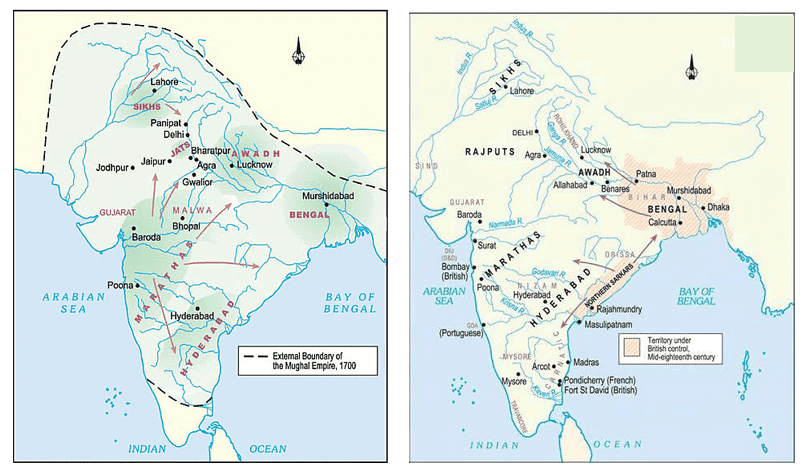 British territories in the mid-eighteenth century
British territories in the mid-eighteenth century
The Crisis of the Empire and the Later Mughals
The Mughal Empire, once prosperous, began to face serious issues in the late 17th century. This was primarily due to Emperor Aurangzeb exhausting the empire's military and financial resources by engaging in a long war in the Deccan.

Breakdown of Administration
- The efficiency of the imperial administration declined under Aurangzeb's successors.
- Powerful nobles, appointed as governors (subadars), gained control over revenue and military administration (Diwani and Faujdari).
- This allowed them to exercise significant political, economic, and military power over vast regions, reduced the authority of the Mughal emperors.
Peasant and Zamindari Rebellions - Rebellions by peasants and zamindars (landlords) in northern and western India added to the empire's problems.
Causes of Revolts:
(i)Some uprisings were triggered by high taxes and economic pressures.
(ii)Other times, powerful local leaders led revolts to strengthen their own positions.Seizing Control: Unlike earlier challenges to Mughal authority, these rebellious groups were now able to take over economic resources and establish their own control.
Weakening of Mughal Control: After Aurangzeb, the Mughal emperors struggled to stop the shift of power and economic control to regional governors, local chieftains, and other groups.
Invasions and Raids
- In 1739, Nadir Shah from Iran invaded and looted Delhi, taking a huge amount of wealth with him.
- Afghan Raids by Ahmad Shah Abdali: After Nadir Shah's invasion, Ahmad Shah Abdali from Afghanistan conducted multiple raids on northern India, invading the region five times between 1748 and 1761.
Factionalism and Instability
- Different groups of nobles, divided into the Iranis and Turanis, competed for power within the Mughal court.
- Later, Mughal emperors became puppets and were controlled by either of these powerful groups.
- The rulers felt ashamed and were treated badly, with some being killed and others being blinded by noble people.
- The most severe disgrace occurred when two rulers of the Mughal dynasty, Farrukh Siyar (1713–1719) and Alamgir II (1754–1759), were killed, and two others, Ahmad Shah (1748–1754) and Shah Alam II (1759–1816), had their vision taken away by their trusted advisors.
 Farrukh Siyar received a noble in court.
Farrukh Siyar received a noble in court.
Rise of Provincial Authorities
- With the decline of Mughal authority, governors of large provinces, known as subadars, along with powerful zamindars, strengthened their control in various parts of the subcontinent.
- Areas such as Awadh, Bengal, and Hyderabad experienced the emergence of these provincial powers, leading to a decrease in the regular payment of revenue to the Mughal capital.
- Rebellions by peasants and zamindars across northern and western India contributed to these issues, often driven by rising taxes and efforts by strong chieftains to fortify their positions.
Three Main Groups of States during the 18th Century:
Old Mughal Provinces: States like Awadh, Bengal, and Hyderabad were once Mughal provinces. While powerful and independent, they maintained formal ties with the Mughal emperor.
Watan Jagirs: Some states, including various Rajput principalities, had considerable independence under the Mughals as Watan Jagirs.
States Controlled by Marathas, Sikhs, and Jats: The third group comprised states under the influence of Marathas, Sikhs, and others like the Jats. These states, varying in size, gained independence through long-lasting armed struggles against the Mughals.
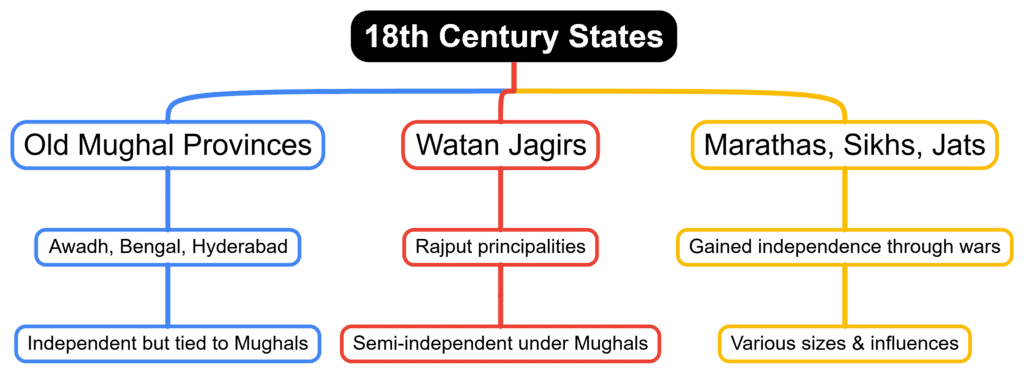
The Rajputs
Many Rajput kings, particularly those from Amber and Jodhpur, served under the Mughal Empire and gained distinction. In return, they were granted significant autonomy in their territories known as Watan Jagirs.

- Attempting Control: In the 18th century, these influential Rajput rulers aimed to expand their authority beyond their existing territories. Ajit Singh the ruler of Jodhpur, also played a role in the politics at the Mughal court.
- Claiming Rich Provinces: The Rajput families sought to gain control over the prosperous provinces of Gujarat and Malwa. Raja Ajit Singh held the governorship of Gujarat, while Sawai Raja Jai Singh governed Malwa. These positions were renewed by Emperor Jahandar Shah in 1713.
- Territory Expansion: The Rajputs also sought to extend their territories by capturing neighboring regions that were under imperial control. The house of Jodhpur conquered Nagaur and added it to their domain, while Amber seized significant portions of Bundi.
- New Capitals and Subadari: Sawai Raja Jai Singh established his new capital in Jaipur and was appointed as the subadar (governor) of Agra in 1722, further strengthening Rajput power.
- Maratha Pressure: The Maratha campaigns in Rajasthan from the 1740s onwards exerted immense pressure on these Rajput principalities and restrained their further expansion.
Seizing Independence
(i) The Sikhs
The Sikhs formed a political community in the seventeenth century, contributing to the development of regional governance in the Punjab. Guru Gobind Singh fought several battles against Rajput and Mughal rulers, both before and after establishing the Khalsa in 1699. Following his death in 1708, the Khalsa rebelled against Mughal rule under Banda Bahadur's command.
Guru Gobind Singh JiBanda Bahadur was captured in 1715 and executed in 1716. The Khalsa asserted their independence by minting coins in the names of Guru Nanak and Guru Gobind Singh, and they set up their own administration between the Sutlej and the Jamuna rivers.
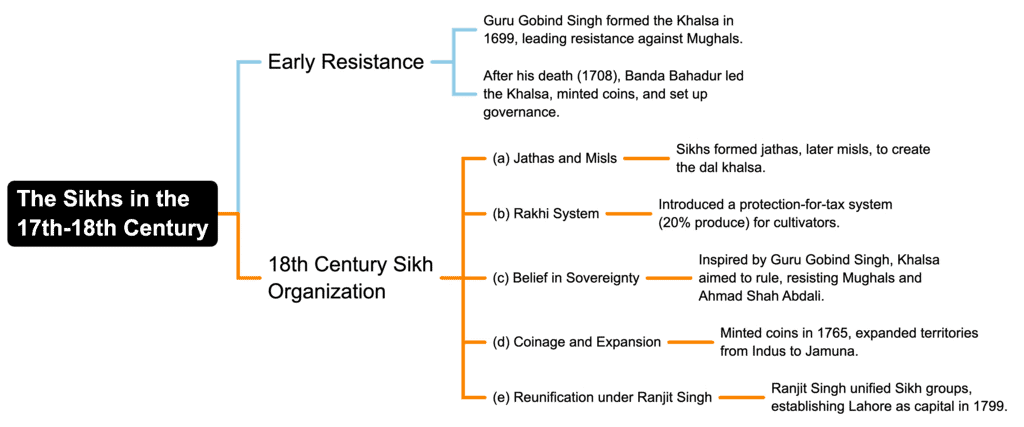 (a) Formation of Bands and Misl:
(a) Formation of Bands and Misl:
- In the eighteenth century, the Sikhs organized themselves into bands known as jathas, and later into misls.
- These groups combined their forces to create the grand army, called dal khalsa.
- They held collective meetings in Amritsar during Baisakhi and Diwali to make important decisions known as "Resolutions of the Guru."
(b) Introduction of the Rakhi System: The Sikhs introduced the rakhi system, where cultivators were offered protection in exchange for a tax payment of 20% of their produce.
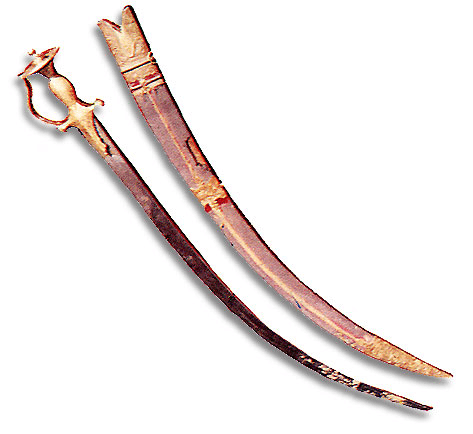
(c) Belief in Sovereignty:
- Inspired by Guru Gobind Singh, the Khalsa believed in their destiny to rule.
- Their strong organization allowed them to resist Mughal governors and Ahmad Shah Abdali, who had seized the Punjab province and the Sarkar of Sirhind from the Mughals.
(d) Coinage and Territorial Expansion:
- The Khalsa declared their sovereignty again in 1765 by minting their own coins, bearing the same inscription as the ones issued during Banda Bahadur's time.
- By the late eighteenth century, Sikh territories spanned from the Indus to the Jamuna rivers, although they were divided under different rulers.
(e) Reunification under Maharaja Ranjit Singh: Maharaja Ranjit Singh played a crucial role in reuniting the Sikh groups and establishing his capital in Lahore in 1799.
(ii) The Marathas
Chhatrapati Shivaji Maharaj (1630-1680), supported by strong warrior families known as deshmukhs, established a stable kingdom that resisted Mughal control. The Maratha army mainly consisted of agile peasant-pastoralists, who were essential to their military strength. Shivaji effectively used these troops to confront the Mughals in the peninsula, successfully creating a robust kingdom
 (a) The Peshwas and Military Success:
(a) The Peshwas and Military Success:
- After Shivaji's passing, the real power in the Maratha state shifted to a family of Chitpavan Brahmanas who served as Peshwa (chief minister) to Shivaji’s heirs.
- The Marathas established a strong military structure under the Peshwas.
- They successfully bypassed Mughal fortifications, raided cities, and engaged Mughal armies to disrupt their supply lines.
(b) Expansion and Influence:
- Between 1720 and 1761, the Maratha empire grew, gradually decreased Mughal power.
- They captured regions such as Malwa and Gujarat from the Mughals, asserting dominance over the Deccan peninsula.
- By the 1730s, the Maratha ruler was acknowledged as the leading authority in the Deccan, entitled to collect taxes known as Chauth and Sardeshmukhi from the area.
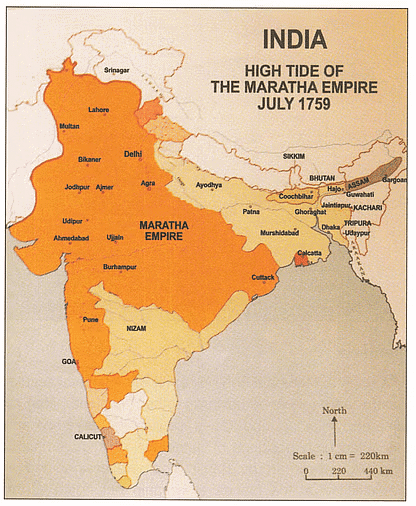 Expansion of the Maratha Empire during 1720-1761
Expansion of the Maratha Empire during 1720-1761
- After raiding Delhi in 1737, Maratha's influence spread swiftly into Rajasthan and Punjab in the north, Bengal, and Orissa in the east, and Karnataka and the Tamil and Telugu regions in the south.
- Though these areas were not officially part of the Maratha empire, they were required to pay tribute, recognizing Maratha's sovereignty.
- The Marathas' military actions created hostility among other rulers, leading to a lack of support during the third battle of Panipat in 1761.
(c) Administrative System and Prosperity:
- The Marathas engaged in numerous military campaigns to expand their territory.
- Besides conquering lands, the Marathas developed an effective administrative system.
- After securing rule, the Marathas gradually introduced revenue demands, considering local conditions.
- They encouraged agriculture and revived trade, providing resources for Maratha chiefs to build strong armies.
- Maratha leaders like Sindhia of Gwalior, Gaekwad of Baroda, and Bhonsle of Nagpur benefited from this setup, allowing them to raise formidable armies.
(d) Trade and Commercial Centers:
- Cities such as Ujjain under Sindhia and Indore under Holkar flourished as significant commercial and cultural hubs.
- Maratha control led to the emergence of new trade routes, facilitating the movement of goods within their territories.
- The prosperity of cities like Ujjain and Indore contributed to cultural exchange and growth.
- New trade routes allowed silk from the Chanderi region to reach Poona, the Maratha capital.
- Burhanpur, involved in the Agra-Surat trade, expanded its trade network to include Poona, Nagpur, Lucknow, and Allahabad.
(iii) The Jats
During the late 17th and 18th centuries, the Jats, like other states, strengthened their authority. Led by Churaman, they gained control over territories west of Delhi. By the 1680s, began to dominate the region between Delhi and Agra. For some time, they acted as the main protectors of Agra.
(a) Prosperous Agriculturists and Trading Centers
- The Jats were prosperous agriculturists, contributing to their wealth and influence.
- Trading centers like Panipat and Ballabhgarh thrived under their dominance.
(b) Emergence of the Kingdom of Bharatpur
- Under Suraj Mal, the kingdom of Bharatpur became a powerful state.
- When Nadir Shah attacked Delhi in 1739, many prominent people took refuge in Bharatpur.
- His son, Jawahir Shah, commanded 30,000 troops and hired an additional 20,000 Maratha and 15,000 Sikh troops to combat the Mughals.
(c) Architectural Influence
- The fort at Bharatpur was constructed in a traditional style, while at Dig, the Jats built a beautiful garden palace that featured elements from Amber and Agra.
- The designs at Dig were inspired by styles linked to royalty from the reign of Shah Jahan.
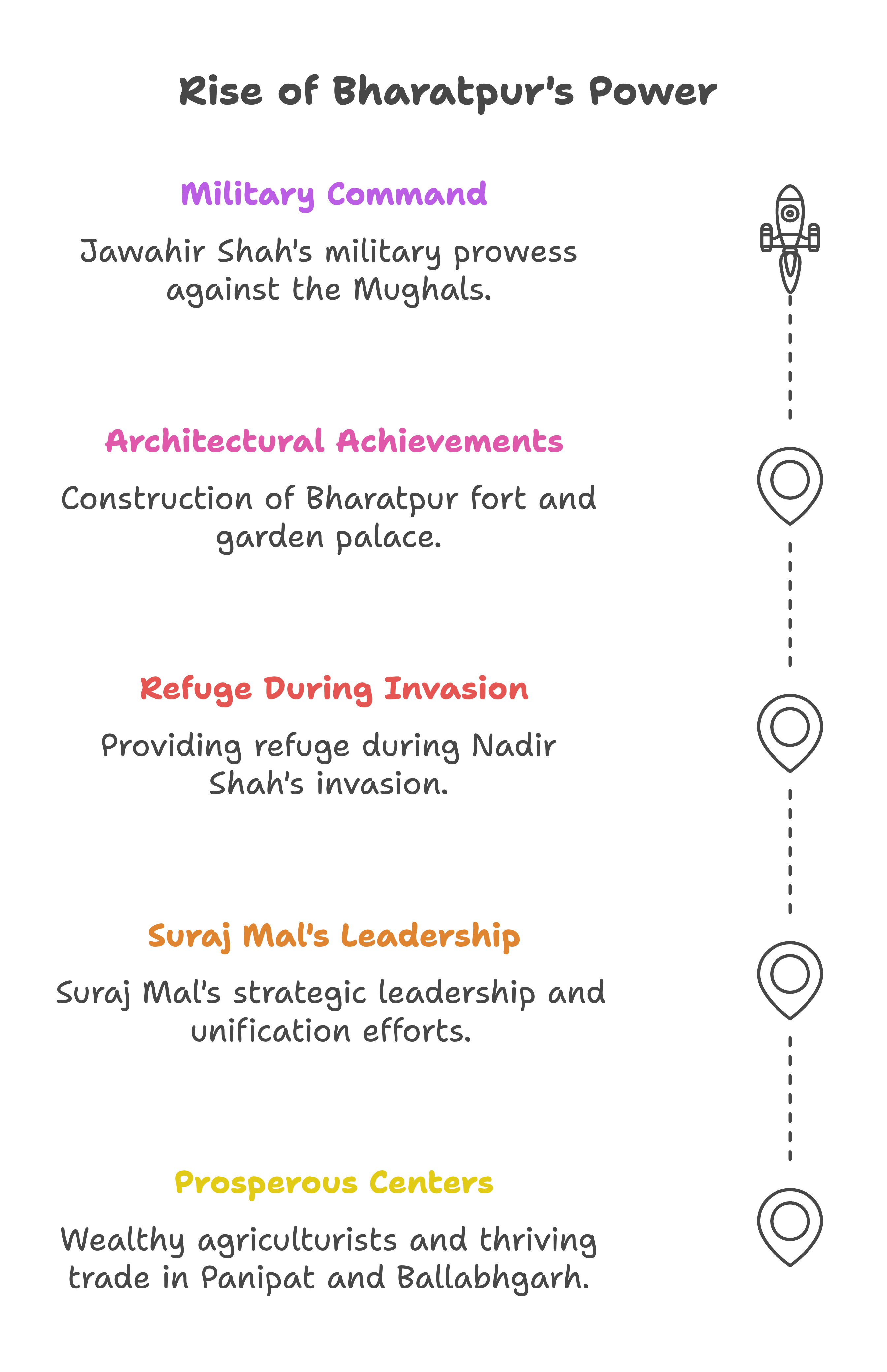
The Jats reached their greatest power under Suraj Mal, who unified the Jat state at Bharatpur (now in Rajasthan) from 1756 to 1763. The areas he controlled included parts of present-day eastern Rajasthan, southern Haryana, western Uttar Pradesh, and Delhi.
Important Events
- 1707 – Aurangzeb died.
- 1739 – Nadir Shah invaded Delhi.
- 1713-1719 – Farrukh Siyar reigned the Mughal Empire.
- 1754-1759 – Alamgir 11 reigned the Mughal Empire.
- 1724-1748 – Asaf Jah remained the Nizam of Hyderabad.
- 1722 – Burhan-ul-Mulk Sa’adat Khan was appointed Subadar of Awadh.
- 1699 – The year in which Khalsa was instituted.
- 1708 – Guru Gobind Singh died.
- 1715 – Banda Bahadur was captured
- 1716 – Banda Bahadur was executed.
- 1799 – Maharaja Ranjit Singh established his capital at Lahore.
- 1627-1680 – The period of Shivaji.
- 1761 – Third battle of Panipat.
|
63 videos|371 docs|46 tests
|
FAQs on Class 7 History Chapter 8 Notes - Eighteenth-Century Political Formations
| 1. How did the Rajputs seize independence during the crisis of the Mughal Empire? |  |
| 2. What were some of the important events that occurred during the later Mughal period? |  |
| 3. How did the crisis of the Mughal Empire impact the political formations in the eighteenth century? |  |
| 4. How did the Rajputs contribute to the political landscape during the later Mughal period? |  |
| 5. What role did the Rajputs play in the decline of the Mughal Empire? |  |
















